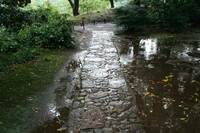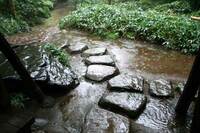- England
- Scotland
- France
- Holland
- Germany
- Italy
- Spain
- Portugal
- USA
- China
- Japan
- India
- Iran
- Advice
- Gardens
- England
- Scotland
- France
- Holland
- Germany
- Italy
- Spain
- Portugal
- USA
- China
- Japan
- India
- Iran
- Advice
- Garden Tours
Book: Landscape Planning and Environmental Impact Design: from EIA to EID
Chapter: Chapter 9 River engineering, channelization and floods
Porous pavements help prevent flooding.
n old towns, most streets were surfaced with gravel. Stone pavements were a luxury for use in grand towns, so that ladies' and gentlemen's clothes were not soiled [Fig 9.16]. When the volume of wheeled traffic increased, moving within and between towns, sealed pavements became necessary. The sealant acts as a 'roof' to stop water entering road foundations and behaving as a lubricant in the substructure. Sealed pavements have greater strength than porous roads. This led people to think they are 'better'. But sealed pavements are only necessary when traffic loadings or traffic volumes are high. For light traffic it is much better to have a porous 'green lane'. If necessary, the surface can be protected from abrasion by a matrix of concrete or geotextile. Natural surface roughness helps to calm traffic speeds [Fig 9.17]. Pedestrians can be provided with smooth porous pavements, because they do not like walking on a rough surface. A good quality self-binding gravel forms an excellent surface. Modern materials are also available. These include porous concrete blocks, bricks and stone with porous joints [Fig 9.18]. Bitumen-macadam can also be porous if it is made with a no-fines aggregate. In time, the effectiveness of porous pavements diminishes, as silt accumulates. In Japan, the traditional solution is to build porous gravel paths with stepping stones. The combination is beautiful and functional.

